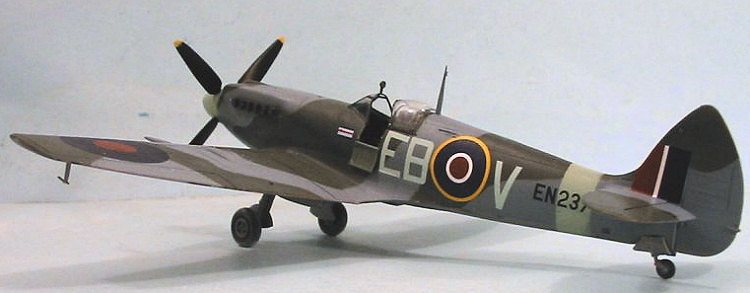
Hasegawa/Aeroclub 1/48 Spitfire XII
| KIT #: | ? |
| PRICE: | £7.23 for the conversion set. |
| DECALS: | ? |
| REVIEWER: | Tom Cleaver |
| NOTES: | Conversion |

| HISTORY |
Almost all of the developmental history of the Spitfire during the Second World War revolved around attempts to outperform the Focke-Wulf Fw-190. In addition to the development of the Spitfire IX, the need to combat the German fighter in its low-level fighter-bomber version led directly to the creation of the Spitfire XII, the first of the Griffon-powered Spitfires.
In
1942, with the Luftwaffe’s bomber force largely engaged on the Eastern
Front, and most of the other bomber units not on the Eastern Front committed to
the Mediterranean, there was almost no offensive capability left among the units
stationed on the Channel Front. The arrival of the Fw-190A-4/U4 jagdbomber
gave JG-26 and JG-2 the capability of mounting low-level raids on southern
England. Each unit had a Jabostaffel, giving a total of 24 aircraft
between the two units for attacking England. These airplanes gave the RAF fits,
since their tactic was to cross the Channel at wave-top height, under the radar,
and hit various towns  and other targets in southeastern England with two to four
aircraft per mission. After dropping their bomb, each Wurger would dive back to
wave-top height and skedaddle at full-throttle back to northern France. They
were called "tip and run" raids. While they did little real damage, the raiders
gave the RAF a major headache because of the public outcry over the raids, which
forced the RAF to employ a much larger force in an attempt to stop the Jabos.
and other targets in southeastern England with two to four
aircraft per mission. After dropping their bomb, each Wurger would dive back to
wave-top height and skedaddle at full-throttle back to northern France. They
were called "tip and run" raids. While they did little real damage, the raiders
gave the RAF a major headache because of the public outcry over the raids, which
forced the RAF to employ a much larger force in an attempt to stop the Jabos.
Given the short response time between spotting the raiders inbound and their retreat to France, the only defense was to mount standing patrols over southern England. This required a much larger force of aircraft on these duties than the Germans were using for the attacks. The Spitfire V - the main equipment of Fighter Command at the time - was no match for the Fw-190 in conventional combat, and was nowhere near fast enough to catch its opponent at low level. In 1942, the Hawker Typhoon was the only RAF fighter with any chance of catching up to the Fw-190 Jabos in a low-level stern chase once the German fighter was free of its bomb, and even then this only worked if the controllers had positioned them well. Something better was needed, and needed fast.
The single-stage Rolls-Royce Griffon II engine had become available in late 1940, offering a considerable increase in power over the Merlin at low altitudes. The Spitfire IV (Type 337) - later renumbered the Spitfire XX after the arrival of the photo-recon P.R.IV series - had been developed to use this power plant, with first flight of the prototype DP485 coming in 1941. Further development was desultory until the arrival of the German Jabos. With the focus on a low-altitude fighter capable of chasing and catching the Focke-Wulfs, the Type 366 Spitfire XII quickly appeared, this being a Mark Vc airframe powered by a Griffon II. The airplane’s top speed at 5,000 feet was 393 m.p.h., which was fast enough to catch the Fw-190s. One hundred Spitfire XIIs were eventually built, based on the Mk.V and Mk.VIII airframes. Originally, these were visually distinguished by having either a fixed (Mk. V) or retractable (Mk.VIII) tail wheel, though all were modified to have the retractable unit during the course of 1943, as well as eventually being equipped with the later horizontal stabilizer and enlarged elevators. The wings were clipped to improve the rate of roll at lower altitude.
In February 1943, 41 Squadron exchanged its Spitfire Vbs for Spitfire XIIs. For the pilots, the primary difference was that the Griffon rotated in the opposite direction to the Merlin, giving a strong swing to the right on takeoff rather than the previous left swing. The unit was declared operational in April 1943 and moved to Hawkinge in southeastern England. Their first victory was a Ju-88 shot down off Calais on April 17. That same month, 91 Squadron began their conversion, joining 41 at Hawkinge in May.
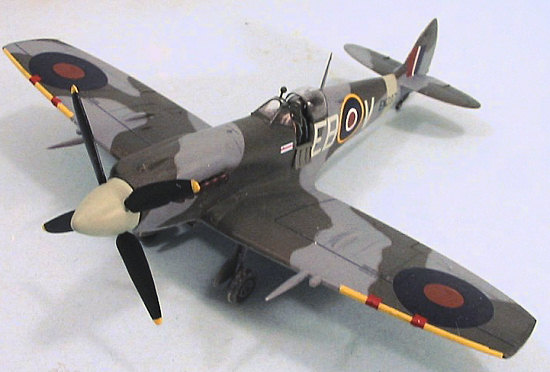 The worst problem the pilots faced at the outset was convincing the Typhoon
pilots that the Spitfire XII, which had clipped wingtips, was not a Bf-109. If
the Spitfire pilot spotted the diving Typhoon in time, they could just outrun
the big Hawker fighter.
The worst problem the pilots faced at the outset was convincing the Typhoon
pilots that the Spitfire XII, which had clipped wingtips, was not a Bf-109. If
the Spitfire pilot spotted the diving Typhoon in time, they could just outrun
the big Hawker fighter.
On May 25, 1943, six Spitfire XIIs of 91 Squadron intercepted a force of Focke-Wulf Jabos attacking Folkestone and claimed six in the cross-Channel chase that ensued, two being claimed by the OC, Sqn Ldr Ray Harries. By August, Harries had become the first pilot to score more than five victories in the Mk. XII and was promoted to Wing Commander to lead the two squadrons.
The Wing fought its most successful action on October 20, 1943, when the two squadrons mounted a fighter sweep over northern France. Near Rouen, they were attacked by 25 Fw-190s and Bf-109Gs of JG26. In the battle that followed, the Mk. XII pilots claimed eight Germans for no losses to themselves.
The Mk. XII remained in service through the summer of 1944, when it was used against the V-1 "buzz bombs." 41 and 91 converted on to the Spitfire XIV in late August before moving to the Continent that fall.
| THE KIT |
There has never been a kit made of the Spitfire XII in 1/48, though one was
announced by Gavia back in 2002 that has yet to see the light of day. In the
1980s, Falcon made a good vacuform conversion that provides a fuselage, spinner
and prop, for use with the Airfix Spitfire Vb kit. This makes up into a good
looking model and is still available - ten years ago I used it with a Hasegawa
Spitfire Vb to make the conversion. In the mid 1990s, Jules Bringuer produced a
resin Mk. Vc wing for use with the then-new Tamiya Mk.V kit, and followed it
with a further c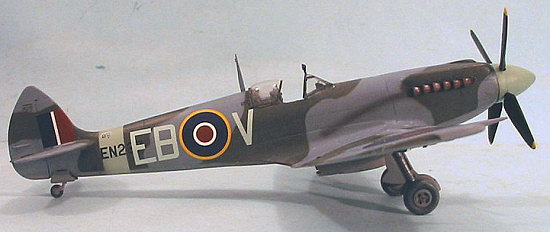 onversion that provided the wing, cowling, prop and spinner in
resin to create a Mk. XII from the Tamiya kit. These sets are long out of
production, though I was fortunate enough to find one on the half-price table of
one of the dealers at the IPMS-USA convention in Chicago in 2001.
onversion that provided the wing, cowling, prop and spinner in
resin to create a Mk. XII from the Tamiya kit. These sets are long out of
production, though I was fortunate enough to find one on the half-price table of
one of the dealers at the IPMS-USA convention in Chicago in 2001.
Modelers - including yours truly - have over the years kit-bashed the cowling, spinner and prop, and rudder of the Hobbycraft Seafire XV with various Spitfire V kits to create a Spitfire XII, but the inaccuracies of the Hobbycraft kit make this work ultimately an exercise in frustration.
Following his creation of a corrected fuselage for use with the otherwise-excellent Hasegawa Spitfire IX kit, John Adams has now created what is likely to be the definitive Spitfire XII set with this conversion. The conversion provides an accurate fuselage, prop, spinner, under wing oil cooler (with a mounting plug), and carb intake in limited-run plastic, with white metal exhaust stacks. These are used with the Hasegawa kit’s cockpit interior, wing, horizontal stabilizers, canopy and landing gear. The set does not provide decals, but if a modeler has the beautiful Victory Decals “Spitfire: Aces of the Empire” sheet, two well-known Spitfire XIIs are included there, including the airplane flown by Ray Harries.
| CONSTRUCTION |
The Aeroclub conversion is a limited-run set, and needs the kind of basic
cleanup most limited-run kits need. I sanded the centerline join areas of
each half to insure they were smooth. I also sanded the inside of the vertical
fin to be certain it would be thin enough when glued together, and test fitted
the Hasegawa kit’s rudder for fit 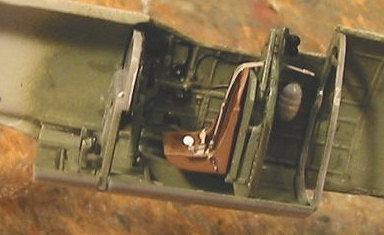 conformity.
The kit comes with the retractable tail wheel option as part of the fuselage
halves. If a modeler wants to do the earlier incarnation with the fixed
tail wheel, they will need to cut away that area and replace it with the correct
parts from the Hasegawa kit.
conformity.
The kit comes with the retractable tail wheel option as part of the fuselage
halves. If a modeler wants to do the earlier incarnation with the fixed
tail wheel, they will need to cut away that area and replace it with the correct
parts from the Hasegawa kit.
Once I was sure the parts fit right, I proceeded to paint and assemble the cockpit, using Xtracrylix British Interior Green and Black for the cockpit, and Schockolade Braun for the seat . Since I had the Eduard photoetch set for the Spitfire IX that was developed for the Airfix kit, I used this and replaced the instrument panel with the Eduard photoetched one, as well as other small detail parts in the cockpit. I also used the seatbelts from the Eduard set. When the Hasegawa cockpit was assembled, I glued it into the Aeroclub fuselage halves, after cutting out the side flap area and glued the fuselage together.
 I
then assembled the Hasegawa wing. I sanded off the bulge over the wheel well,
which was an entirely postwar phenomenon, and glued in the plug for the left
radiator. I sanded this smooth, cove
I
then assembled the Hasegawa wing. I sanded off the bulge over the wheel well,
which was an entirely postwar phenomenon, and glued in the plug for the left
radiator. I sanded this smooth, cove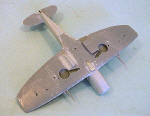 red it with Mr. Surfacer, sanded it smooth
again, and then glued the oil cooler in position. I then attached the wing to
the fuselage and also attached the carb intake. There were gaps around, which I
first filled with cyanoacrylate glue and then filled with Mr. Surfacer. I also
attached the horizontal stabilizers after cutting off the tabs, and then filled
the gaps there with cyanoacrylate glue. I also filled the fuselage centerline
seam with glue, then covered it with Mr. Surfacer.
red it with Mr. Surfacer, sanded it smooth
again, and then glued the oil cooler in position. I then attached the wing to
the fuselage and also attached the carb intake. There were gaps around, which I
first filled with cyanoacrylate glue and then filled with Mr. Surfacer. I also
attached the horizontal stabilizers after cutting off the tabs, and then filled
the gaps there with cyanoacrylate glue. I also filled the fuselage centerline
seam with glue, then covered it with Mr. Surfacer.
Once all the fillers had set, I sanded everything smooth and then rescribed panel lines as necessary.
| COLORS & MARKINGS |
Painting: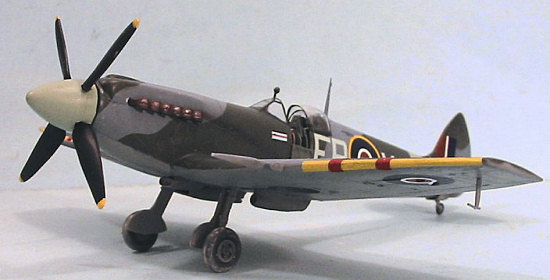
The model was painted entirely with Xtracrylix paints. I first “pre-shaded” with Black along all the panel lines, then applied Sky for the fuselage band. When dry, this was masked off and I gave the model the standard camouflage of Medium Sea Grey lower surfaces with Ocean Grey and Dark Green upper surfaces. When this was all dry I gave the model a coat of Xtracrylix Gloss Varnish.
Decals:
Having used the Spitfire XII decals on my Victory Decals “Spitfire: Aces of the Empire” sheet for other models, I was forced to come up with decals for this model out of the decal dungeon. I pieced things together to do the Spitfire XII flown by Squadron Leader Thomas Neill, the Commanding Officer of 41 Squadron in 1943, using a profile in the Osprey “Late Marque Spitfire Aces” book as a guide. The stencil decals from the Hasegawa sheet were also used.
| FINAL CONSTRUCTION |
I gave the model a coat of Xtracrylix Flat Varnish, then attached the Falcon vac canopy in the open position. I used the photo-etch side flap from the Eduard set. The white metal exhausts seemed a bit large, so I used the fishtail exhausts left over from the Hasegawa P-39Q kit, which look right according to photos of Spitfire XIIs. The landing gear and prop was attached, and I then applied oil stains on the underside and exhaust stains on the fuselage, using Tamiya “Smoke.”
| CONCLUSIONS |
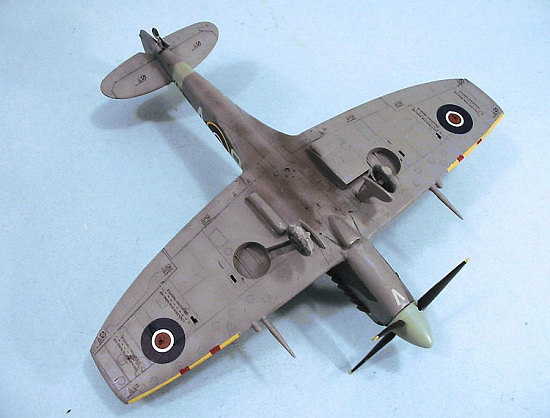 I
don’t know why, but the Spitfire XII has been my favorite Spitfire version since
the first time I ever saw a photograph of one, when I first bought William
Green’s “Famous Fighters of the Second World War, Volume I” 50 years ago this
year. Yes, there are other marks of Spitfire with greater records of
achievement, but aesthetically the Spitfire XII really strikes my fancy. This
Aeroclub conversion for the Spitfire XII is as easy to use as their Spitfire IX
correction set is, and as accurate. I realized while I was doing this project
that this month marks 20 years since I first bought an Aeroclub kit (the Gloster
Gamecock vacuform), and I have been building kits and using parts and correction
sets created by John Adams ever since. His work is so reliable that the only
recommendation I need to have to get hold of Aeroclub products is the knowledge
he did them.
I
don’t know why, but the Spitfire XII has been my favorite Spitfire version since
the first time I ever saw a photograph of one, when I first bought William
Green’s “Famous Fighters of the Second World War, Volume I” 50 years ago this
year. Yes, there are other marks of Spitfire with greater records of
achievement, but aesthetically the Spitfire XII really strikes my fancy. This
Aeroclub conversion for the Spitfire XII is as easy to use as their Spitfire IX
correction set is, and as accurate. I realized while I was doing this project
that this month marks 20 years since I first bought an Aeroclub kit (the Gloster
Gamecock vacuform), and I have been building kits and using parts and correction
sets created by John Adams ever since. His work is so reliable that the only
recommendation I need to have to get hold of Aeroclub products is the knowledge
he did them.
If you like Spitfires, you’ll want this kit in your collection. Highly recommended.
February 2007
Review Kit courtesy of Aeroclub. Get yours at:
If you would like your product reviewed fairly and fairly quickly, please contact the editor or see other details in the Note to Contributors.